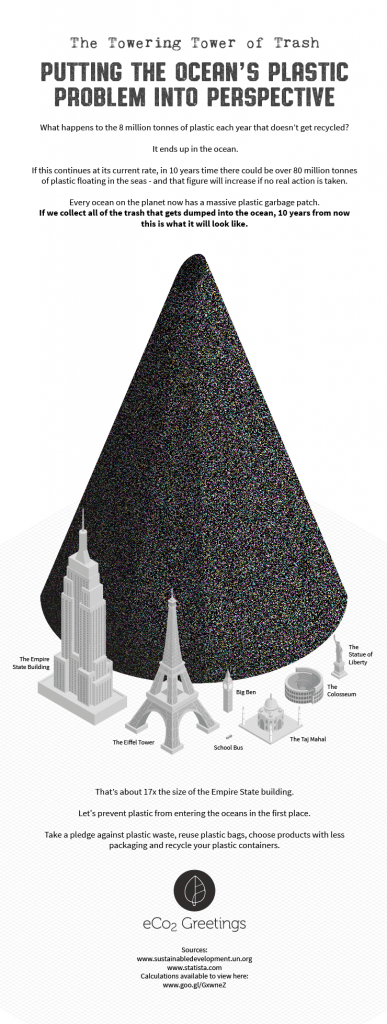Our planet has a population of over 7.5 billion people and as a result we dump a massive 2.12 billion tonnes of waste per year. This is partly because 99% of the stuff we buy gets binned within 6 months of purchasing – this isn’t including food, human, electronic and medical waste either.
This waste ends up in a variety of different locations; landfill sites, dumps, and worst of all the sea. If it continues at its current rate, in 10 years time there could be over 80 million tonnes of plastic floating in our seas – and that figure will continue to increase if no real action is taken soon. To put that into perspective, that’s almost 17 times bigger than the Empire State Building in, which is 443 metres tall – big, right?
It is estimated that up to 267 marine species are affected by plastic pollution within the ocean – and that’s just in the South Pacific Garbage Patch alone. So how can we – as a globe – start to reduce the amount of waste that goes into our oceans?
Well, there are simple ways to do this, such as; reusing your plastic bags, recycling all of your rubbish, supporting river and beach clean ups, avoiding microbeads in your face and handwashes (that’s if they haven’t been banned in your country already) and spreading the word about organisations that are addressing plastic pollution.
When plastic enters the ocean it slowly gets broken down into tiny pieces and then digested and metabolised by fish and microbes which eventually get released as a carbon dioxide again which is a vicious cycle that needs to be stopped.?
The plastic that is ending up in oceans is being transported all around the globe with currents. Imagine remote beaches on small Pacific islands, British coves and even in Arctic ice just covered in plastic.
Imagine the sea life food chain; seaweed, zooplankton, small fish, large carnivorous fish, squid and finally sharks and dolphins – now there is plastic of all shapes and sizes affecting this food chain and even ending up back on our plates.
If you’re still struggling to comprehend the amount of rubbish in our oceans, picture this: the waste in our seas is now twice the size of France and France is 598 miles long from North to South which would take 9 hours and 12 minutes to drive the distance. Now double that and that’s how much waste is in our ocean. Crazy!
If that has shocked you as much as it shocked us you’re now most likely looking for ways to reduce your plastic usage. Here are a few ways you can help our oceans:
- Stop using plastic straws – They can easily get stuck in sealife’s mouths, noses and get mistaken for food
- Reuse your shopping bags – A simple way to cut plastic usage is to reuse your shopping bags
- Give up gum – Gum is made of a synthetic rubber aka plastic
- Purchase products in boxes not plastic bottles – Cardboard decomposes so it is far better for our environment?
Eat fresh produce that doesn’t come in plastic cartons and boxes – This will work out better for you as you’ll be eating fresh produce and also saving the planet. A win, win situation!
So, next time you get a straw in your drink or get offered a plastic bag while doing your weekly food shop, think about our ocean. Take a look at the piece by Eco2 here which shows just how much of a difference you could make to our planet?

